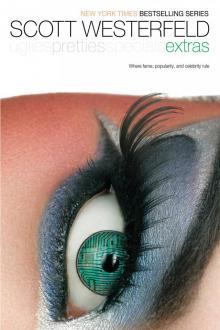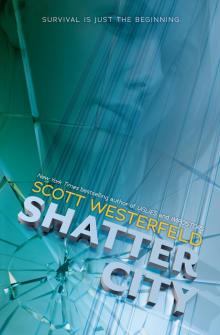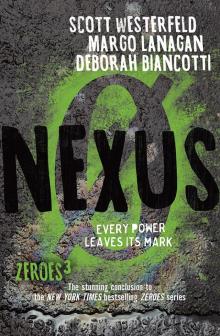- Home
- Scott Westerfeld
Peeps p-1 Page 8
Peeps p-1 Read online
Page 8
Lice are bloodsuckers that live on people’s heads. So small that you can barely see them, they hide in your hair. Once they’ve infested one person, they spread like a rumor, carrying trench fever, typhus, and relapsing fever. Like most bloodsuckers, lice are unpopular. That’s why the word lousy is generally not a compliment.
You can’t fault lousy loyalty, though. Human lice have been with us for five million years, since our ancestors split off from chimpanzees. That’s a long run together. (The tapeworm, for comparison, has only been inside us for about eight thousand years, a total parasite-come-lately.) At the same time we were evolving away from monkeys, our parasites were evolving from monkey parasites—coming along for the ride.
But I bet that our lice wish they hadn’t bothered. You see, while the chimps stayed hairy, we humans lost most of our body hair. So now human lice have only our hairy heads to hide in. On top of that, they’re always getting poisoned by shampoo and conditioner, which is why lice have become rare in wealthy countries.
But lice aren’t utterly doomed. When people started wearing clothing, some lice evolved to take advantage of the new situation. They developed claws that are adapted for clinging to fabric instead of hair. So these days, there are two species of human lice: hair-loving head lice and clothes-loving body lice.
Evolution marches on. Maybe one day we’ll have space suit lice.
So what does this have to do with the invention of clothing?
Not long ago, scientists compared the DNA of three kinds of lice: head lice, body lice, and the old original chimp lice. As time passes, DNA changes at a fixed rate, so scientists can tell roughly how long ago any two species split up from each other. Comparing lice DNA soon settled the question of what came first—the clothes or the nakedness.
Here’s how it happened:
Human lice and monkey lice split off from each other about 1.8 million years ago. That’s when ancient humans lost their body hair and the lice we inherited from the chimps had to adapt, evolving to stick to our heads.
But head lice and body lice didn’t split until seventy-two thousand years ago, an eternity later (especially in lice years). That’s when human beings invented clothes, and body lice evolved to reclaim some of their lost real estate. They got brand-new claws and spread down into our brand-new clothing.
So that’s the answer: Clothes got invented after we lost our body hair. And not right away; our primate ancestors ran around naked and hairless for well over a million years.
That part of human evolution is written in lousy history, in the genes of the things that suck our blood.
Chapter 9
UNDERWORLD
Just as I finished Freddie’s apartment (finding no glimmer of bodily fluids), my phone buzzed. One of the Shrink’s minders was on the other end, saying that she wanted to see me again. My stack of forms had returned from Records, chock-full of enough intrigue to bounce all the way up to the Shrink. That was always a sign of progress.
Still, I sometimes wished she would just talk to me on the phone and not insist on quite so much face time. But she’s so old-school that telephones just aren’t her thing. In fact, electricity isn’t her thing.
I wonder if I’ll ever get that ancient.
I took the subway down to Wall Street, then walked across. The Shrink’s house is on a crooked alley paved with cobblestones, barely one car wide. It’s one of those New Amsterdam originals that the Dutch laid down four centuries ago, running on the diagonal, flouting the grid in the same grumpy way that the Shrink ignores telephones. Those early streets possess their own logic; they were built atop the age-old hunting trails of the Manhattan Indians. Of course, the Indians were only following even more ancient paths created by deer.
And who were the deer copying? I wondered. Maybe my route had first been cut through the primeval forest by a line of hungry ants.
One thing about carrying the parasite—it makes you feel connected to the past. As a peep, I’m a blood brother to every other parasite-positive throughout the ages. There’s an unbroken chain of biting, scratching, unprotected sex, rat reservoirs, and various other forms of fluid-sharing between me and that original slavering maniac, the poor human who was first infected with the disease.
So where did he or she get it from? you may ask. From elsewhere in the animal kingdom. Most parasites leap to humanity from other species. Of course, it was a long time ago, so the original parasite-positive wasn’t exactly what we’d call human. More likely the first peep was some early Cro-Magnon who was bitten by a dire wolf or giant sloth or saber-toothed weasel.
I kicked a bag of garbage next to the Shrink’s stoop and heard the skittering of tiny claws inside it. A few little faces peeked out to glare at me; then one rat jumped free and scampered a few yards down the alley, disappearing down a hole among the cobblestones.
There are more of those holes than you’d think.
When I first came to the city, I saw only street level, or sometimes caught glimpses of the netherworld through exhaust grates or down empty subway tracks. But in the Night Watch we see the city in layers. We feel the sewers and the hollow sidewalks carrying electrical cables and steam pipes, and below that the older spaces: the basements of fallen buildings, the giant buried caskets of abandoned breweries, the ancient septic tanks, the forgotten graveyards. And, struggling to get free underneath, the old streambeds and natural springs—all those pockets where rats, and much bigger things, can thrive.
Dr. Rat says that the only creatures that ever come out onto the surface are the weak ones, the punks who aren’t competitive enough to feed themselves down where it’s safe. The really big things, the rat kings and the other alpha beasties, live and die without ever troubling the daylight world. Think about that for a second: There are creatures down there who’ve never seen a human being.
The laden sky rumbled overhead, and I smelled rain.
History. Nature. Weather. My head was pounding, full of those big, abstract words that have their own cable channels.
But it was the sound of those tiny scratching feet inside the garbage bag that followed me into the Shrink’s house and down the corridor to her session room, pushed along by an invisible wind.
“Most impressive, Cal.” She leafed through papers on her desk. “All it took was a few drinks to get you back to Morgan’s house.”
“Yeah. But it was an apartment, Dr. Prolix. Not many houses in Manhattan these days, you might have noticed.”
The guy from Records in the other visitor’s chair raised his eyebrows at my tone, but the Shrink only folded her hands and smiled. “Still glum? But you’re making such progress.”
I chewed my lip. The Shrink didn’t need to know what I was bummed about. Not that it mattered anymore, the whole stupid way I’d had Lace help me. Even if she’d gone on believing me, hanging out with her would have just gotten more and more torturous.
Worse than that, it had been dangerous. Lace hadn’t showed a bit of interest—not that kind of interest anyway—and I’d still come close to kissing her.
Never again. Lesson learned. Move on. I was back in lone-hunter mode now.
“Yeah, gallons of progress,” I said. “You saw what I found on the wall?”
“I read your 1158-S from this morning, yes.”
“Well, I went back there today but didn’t find anything more on the creepy graffiti front. Or much else. Morgan moved out at least seven months, ago. Not exactly an oven-fresh trail.”
“Cal, eight months is the blink of an eye for Records. To find out where Morgan has gone, perhaps we should look at where she came from.”
“What do you mean?”
“The history of that property has proven interesting.” She turned to the Records guy and waved her pale hand.
“When the landlords in question filed their initial rent-control forms,” he began, “there were four residents on the seventh floor.” His voice quivered slightly, and once or twice as he read, his eyes darted up to the creepy dolls, con
firming that he wasn’t comfortable in the Shrink’s office. Not a hunter, just an average working stiff with a city job. His chair was backed as far away from the red line as it could go. No typhoid germs for him. “We ran the names of these individuals through the city databases and hit a missing persons report from March this year.”
“Only one?” I asked. “I figured they’d all be missing.”
He shook his head. “More than one missing person from the same address, and we would have already filed an MP-2068 with you guys. But there was only one hit. NYPD has no leads, and at this point it’s pretty much a dead investigation.”
Given what I’d seen in Lace’s apartment, that wording was appropriate. “So let me guess: The guy who lived in 701 is gone.” So pretty I just had to eat him.
The man from Records nodded. “That’s right, 701. Jesus Delanzo, age twenty-seven. Photographer.” He looked up at me, and when I didn’t say anything, he continued, “Apartment 702 was occupied by Angela Dreyfus, age thirty-four. Broker.”
“Where does she live now?”
He frowned. “We don’t exactly have an address for her. Just a post office box in Brooklyn, and a cell phone that doesn’t answer.”
“Rather anonymous, don’t you think?” the Shrink said.
“And her friends and family don’t think it’s weird she lives in a post office box?” I asked.
“We don’t know,” the Records guy said. “If they’re worried, they haven’t filed with the NYPD.”
I frowned, but the Records guy kept going. “A couple lived in the other apartment—703. Patricia and Joseph Moore, both age twenty-eight. And guess what: Their mail forwards to the same post office box as Angela Dreyfus’s, and they have the same phone number.” He leaned back, crossed his legs, and smiled, rather pleased to have put such a juicy coincidence on my plate.
But his last words hadn’t even gotten through to me yet. Something else was really wrong.
“That’s only three apartments. What about 704?”
He raised an eyebrow, looked down at his printouts, and shrugged. “Unoccupied.”
“Unoccupied?” I turned to the Shrink. “But that’s where Morgan lived. Her junk mail is still showing up there.”
The Records guy nodded. “The post office doesn’t forward junk mail.”
“But why don’t you have a record of her?”
He leafed through his folder as he shook his head. “Because the landlord never filed an occupancy form for that apartment. Maybe they were letting her live there for free.”
“For free? Fat chance,” I said. “That’s a three-grand-a-month apartment.”
“Actually, more like thirty-five hundred,” the Records guy corrected.
“Ouch,” I said.
“The rent is not the most unsettling thing about that building, Cal,” the Shrink said. “There was something else Records didn’t notice until you prompted them to look.”
The guy glanced sheepishly down at his papers. “It’s not anything we usually flag for investigation. But it is … odd.” He shuffled papers and unrolled a large set of blueprints across his knees. “The building plans show an oversize foundation, much deeper and more elaborate than one would expect.”
“A foundation?” I said. “You mean, the part that’s underground?”
He nodded. “They didn’t have the air rights to put up a tall building, because it would block views of the river. So they decided to make some extra space below. There are several subbasements descending into the granite bedrock, spreading out wider than the building overhead. Room for a two-floor health club, supposedly.”
“Health club in the basement.” I shrugged. “Not surprising in a ritzy place like that.”
The Shrink drew herself up. “Unfortunately, this health club is not in a particularly healthy location. They excavated too close to the PATH tunnel, an area where the island is very … porous. That tunnel was only finished in 1908. Not everything stirred up by the intrusion has settled yet.”
“Not settled yet?” I said. “After a hundred years?”
The Shrink steepled her fingers. “The big things down there awaken slowly, Kid. And they settle slowly, too.”
I swallowed. Every old city in the world has a Night Watch of some kind, and they all get nervous when the citizens start digging. The asphalt is there for a very good reason—to put something solid between you and the things that live underneath.
“It’s possible that this excavation has opened the lower environs,” the Shrink said, “allowing something old to bubble up.”
“You think they uncovered a reservoir?”
Neither of them said anything.
Remember what I said about rats carrying the disease? How broods store the parasite in their blood when their peeps die? Those broods can last a long time after the peeps are gone, spreading the disease down generations of rats. Old cities carry the parasite in their bones, the way chicken pox can live in your spinal column for decades, ready to pop out as horrible blisters in old age.
“The health club, huh?” I said, shaking my head. “That’s what people get for working out.”
“It may be more than a reservoir, Cal. There may be larger things than rats and peeps to worry about.” The Shrink paused. “And then … there are the owners.”
“The owners?” I asked.
The man from Records glanced at the Shrink, and the Shrink looked at me.
“A first family,” she said.
“Oh, crap,” I answered. One thing about the carriers of the Night Watch: They have a special affection for the families after whom the oldest streets are named. Back in the 1600s, New Amsterdam was a small town, only a few thousand people, and everyone was someone’s cousin or uncle or indentured servant. Certain loyalties go back a long way, and in blood.
“Who are they? Boerums? Stuys?”
The Shrink’s eyes slitted as she spoke, one hand gesturing vaguely toward the half-forgotten world outside her town house. “If I remember correctly, Joseph once lived on this very street. And Aaron built his first home on Golden Hill, where Gold Street and Fulton now meet. Mercer Ryder’s farm was up north a ways—he grew wheat in a field off Verdant Lane, although that field is called Times Square these days. And they had more farmland in Brooklyn. They were good boys, the Ryders, and the Night Mayor has kept up with their descendants, I believe.”
I found my voice. “Ryder, you said?”
“With a y,” the Records guy offered softly.
I swallowed. “My progenitor’s name is Morgan Ryder.”
“Then we have a problem,” said the Shrink.
The guy from Records, whose name was Chip, took me down to his cubicle. We were going over the history of the Hoboken PATH tunnel, which was a lot more exciting than you’d think.
“The first incident was in 1880, killed twenty workers,” Chip said. “Then another in 1882 killed a few more than that. They were supposedly explosions, and the company had the body parts to prove it.”
“Handy,” I said.
“And leggy,” he chuckled. Out from under the soulless eyes of the Shrink’s doll collection, Chip was a certified laugh riot. “That brought the project to a halt for a couple of decades. Those incidents were in Jersey, but on this side of the river we never bought the cover story.”
“Why not?”
“There are ancient tunnels that travel through the bedrock, all around these parts. And around the PATH train, the tunnels are … newer.” His fingers drifted along the tunnel blueprints on his desk. “Check it out, Cal: If you add up the weight of all the plants and animals that live under the ground, it’s actually more than everything that lives above. About a billion organisms in every pinch of soil.”
“Yeah, none of which is big enough to eat twenty people.”
He lowered his voice. “But that’s what happens after you’re buried, Kid. Things in the ground eat you.”
Great, now Records was calling me Kid. “Okay, Chip,” I said. “But worms don’t
eat people who are still alive.”
“But there’s a food chain down there,” he said. “Something has to be at the top.”
“You guys don’t have a clue, do you?”
Chip shook his head. “We have clues. Those tunnels? They’re a lot like the trails of an earthworm through the dirt.”
I frowned and dropped my eyes back to the blueprints for Lace’s building. The fine-lined drawings—precisely scaled and covered in tiny symbols—showed only the shapes that human machines had carved from the soil. No hint at the environment surrounding our descent into the earth. “So you think there are giant worms down there? I thought you guys in Records were a little more … factual.”
“Yeah, well, we read a lot of weird stuff.” He pointed his pen at the edge of the level labeled Health Club, Lower. “This is what somebody should have noticed—and then filed a great big ST-57.” The pen tapped. “The excavation goes too deep for comfort; it’s only a few yards above part of the exhaust system for the PATH tunnel. Any variation from these plans, and they’re connected.”
“Connected to what?”
“You ever seen those big exhaust towers by the river? The fans are about eighty feet across, sucking air all day. Bad.”
“Air is bad?”
“They’re pumping oxygen down there!” Chip shook his head, tossed the pen disgustedly down onto the plans. “That’s like pouring fertilizer on your weeds. Lack of oxygen is the growth-limiting factor in a subterranean biome!”
“Ah, so things are growing. But those ‘explosions’ in Jersey were a hundred and twenty years ago, after all. We’re just talking rats these days, right?”
“Probably,” Chip said.
“Probably. Wonderful.” Standing there in the gloom, I realized that Chip and I were underground right now, tons of bricks and mortar piled up over our heads. The squeaking ceiling fan labored to bring oxygen down to us; without the flickering fluorescents it would be too dark even for my peep eyes to see. Down here was hostile territory—a place for corpses and worms, and the bigger things that ate the worms, and the bigger things that ate them…

 Uglies
Uglies Swarm
Swarm Pretties
Pretties Zeroes
Zeroes The Secret Hour
The Secret Hour Behemoth
Behemoth Peeps
Peeps Specials
Specials Goliath
Goliath Leviathan
Leviathan Extras
Extras Shatter City
Shatter City The Risen Empire
The Risen Empire Touching Darkness
Touching Darkness The Last Days
The Last Days So Yesterday
So Yesterday The Killing of Worlds
The Killing of Worlds Afterworlds
Afterworlds Mirror's Edge
Mirror's Edge Evolution's Darling
Evolution's Darling Blue Noon m-3
Blue Noon m-3 Touching Darkness m-2
Touching Darkness m-2 Impostors
Impostors The Secret Hour m-1
The Secret Hour m-1 Leviathan 01 - Leviathan
Leviathan 01 - Leviathan Peeps p-1
Peeps p-1 Nexus
Nexus Horizon
Horizon Bogus to Bubbly
Bogus to Bubbly Goliath l-3
Goliath l-3 The Last Days p-2
The Last Days p-2 Behemoth l-2
Behemoth l-2 Stupid Perfect World
Stupid Perfect World Goliath (Leviathan Trilogy)
Goliath (Leviathan Trilogy)